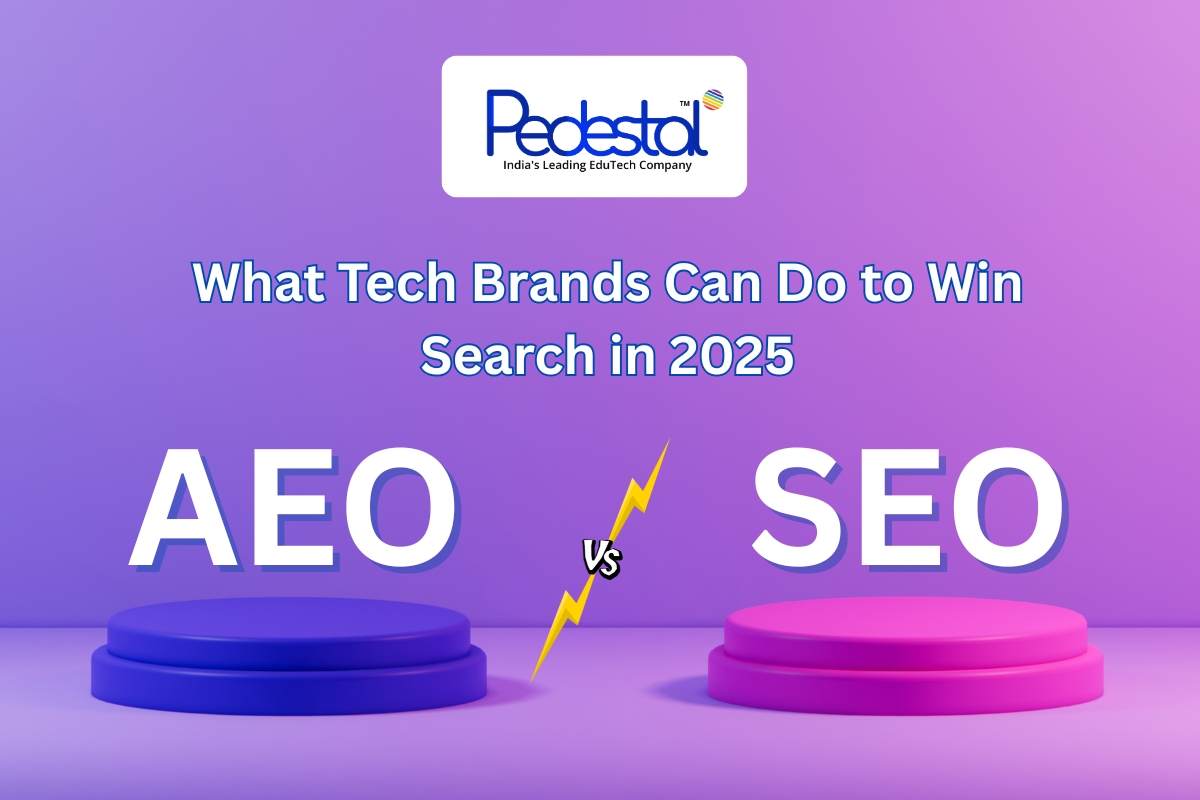The search landscape is rapidly evolving. Organizations that have mastered traditional SEO practices and the emerging opportunity of answer engine optimization will position themselves to be ahead of the game in 2025 and the future.
Let’s see what us, as an edtech company can do to bridge the gap between this information.
The Evolving Search Landscape
It’s one thing to say bye-bye to needing to click through pages of blue links to find information, it’s a completely different experience now. The generations of potential digital marketing candidates and career changers will encounter a wildly different search space and must understand this fundamental shift to remain relevant in their discipline. Once upon a time, “search” meant we could find information at the click of a button. But, we have entered the age of AI-based answer engines, meaning rather than simply helping us navigate to individual websites, these advanced systems will provide very comprehensive answers to our queries. Google’s AI Overviews are just the tip of the iceberg in the evolution of information discovery and consumption of the web.
SEO vs. AEO: Knowing the Difference
SEO principles
SEO is a useful way to rank your website in search engines by:
- Using keywords in a smart way.
- Establishing quality backlinks from reputable websites.
- Improving the technical aspects of a website and
- Using outstanding content that would inspire users to stay on the page.
Tech companies and marketing practitioners or students have been employing these principles for years to drive traffic to their websites.
AEO principles
AEO uses a variety of principles. Primarily, it is ensuring your content is delivered as a direct answer by AI when it generates responses. In order to succeed at AEO, you must:
- Structure content as answers to questions;
- Provide accurate and authoritative fact and information;
- Use logical headings, as well as conciseness in your paragraphs;
- Use schema markup to better inform AI.
Why Tech Brands Need to Start Changing Now
We have been seeing this here at Pedestal Techno World. We have changed our digital marketing lessons, because the stakes could not be higher:
- Featured content takes up the spotlight – When the AI generated answer comes from your content you create massive amounts of exposure and credibility.
- People are searching differently – Especially younger audiences, who expect answers on demand and simply want the points without visiting 18 different websites.
- Voice is on the rise further – AI content optimized will tend to perform better with voice queries, which will typically have one answer.
Tech Specific Tactics for 2025:
-
Question Content Clusters
Marketing Professionals should focus on developing content that is primarily centered on the questions in their niche. When we teach, we focus on:
- Finding actual questions people ask about our products
- Creating pages to drive clear, direct answers
- Group similar questions together to show that you are topical experts.
-
Improve Content with Structured Data
AI algorithms that index your pages love structured data formats, as it helps them create meaning:
- Creating FAQ schema for question-answer-like content
- Utilizing HowTo schema for your tutorials/guides
- Using Product schema for your technology products
- Using Organization schema in order to show differing elements of your brand
We teach hands-on application of these schemas in our digital marketing workshops at Pedestal Techno World.
-
Leverage E-E-A-T Signals
Experience, Expertise, Authoritativeness and Trustworthiness are all more important than ever now with the use of AI:
- Make team member credentials and experience very clear
- Support claims with recent date sources
- Link to IV or II authoritative sources from respected industry sites
- Provide reverse reviews from customers
- Provide extensive case studies that show actual results
-
Optimize for Semantic Search
AI does not just focus on a specific search keyword, it thinks about the relationships with the other concepts associated with the keywords:
- Talk about complete topics, not just focused keyword targets
- Talk in more natural language form, as in “How people talk” – helps keyword adaption
- Use related words/terms/concepts when appropriate
- Develop utilised resource that covered everything and fulfilled their questions
-
Embrace Content Creation in Other Formats
AI is increasingly using other processes of media to pull information on other works:
- Make videos and use the proper tags and describe what they are seeing as a transcript
- Develop an infographic with descriptive alt text
- Record a podcast with very descriptive notes, and timestamps along the way
- Build out interactive tools that provide solutions to specific problems.
Achieving Balance In SEO and AEO For an Optimum Approach
Tech brands that will be very successful in 2025 will utilize both SEO and AEO rather than choose one over the other. At Pedestal Techno World, our corporate trainings rely on their integration:
- Stick to technical SEO fundamentals – Site speed, mobile-friendliness, secure identifying connections, etc. still matter
- Create content that is useful for both traditional search results, as well as, AI answers
- Focus on user experience – You need strong focus on how your content is helpful, and, serving user’s real needs
- Keep the new metrics in mind – Beyond just rankings, be aware of featured snippets, knowledge panels, and appearances in AI answers.
Tools and Resources to Navigate the AI Search Environment
Students and professionals in the digital marketing space should utilize the following tools to be successful:
AI content analysers that assess content for potential in answer engines
Structured data testing tools
Natural language processing (NLP) analysers to improve semantic relevance
Search listening tools to identify new questions being asked in your niche.
Conclusion: The Future is for Adaptive Marketers
As AI is incorporated into search experiences, the delineation between AEO and SEO will be further vague. For tech education companies and brands, results will reflect the value of creating genuinely valuable content for humans and AI.
Here at Pedestal Techno World, we are dedicated to keeping our students and industry partners ahead of the curve. In our specific digital marketing course in Jaipur and online , you will acquire the practical knowledge and experience to thrive in the AI universe.
Again, the premise doesn’t change: if you produce content that really helps people, search engines and answer engines will help you to be seen. It may be different ways of doing it, but the premise of linking something valuable to people who needed it will continue to move digital marketing.
Also Read – Top DevOps Course in 2025: Only at Pedestal Techno World
Interested in mastering these cutting edge digital marketing approaches? Learning more about our digital marketing programs, or how our training programs get you with these skills for the AI age at Pedestal Techno World.



I love how the blog emphasizes the need for tech brands to balance SEO with AEO. It’s all about using structured data and E-E-A-T signals to give AI engines the context they need to serve content efficiently. Tech brands that don’t adapt will miss out on potential visibility.
Great breakdown on the evolving search environment! One thing I’d add is the growing importance of video and audio content in AEO strategies, since answer engines increasingly pull from diverse content formats to serve user intent.
The point about balancing SEO and AEO struck a chord. It’s not about replacing one with the other, but understanding how both can work in tandem to meet users wherever they are in their search journey.
Great insight into the shift towards AEO. I think it’s crucial that tech brands start embracing structured data to enhance their visibility in AI-driven search environments. It’s not just about ranking anymore; it’s about providing the right answer at the right time.
Balancing SEO and AEO seems to be the sweet spot going forward. Your point about creating multi-format content hits home, especially as younger audiences lean more toward video and voice search.
The mention of E-E-A-T and semantic search hit home for me. It’s clear that content quality and contextual relevance are no longer just ‘nice to haves’—they’re essentials in the AEO era.
This post nails the transition we’re all seeing — from keyword-heavy content to context-rich, AI-friendly formats. It makes me think: will traditional keyword research soon take a backseat to user intent modeling entirely?
It’s fascinating to see how the search journey is becoming more answer-driven. The idea of balancing SEO with AEO really resonates—especially for content-heavy industries like edtech where accuracy and authority are crucial.